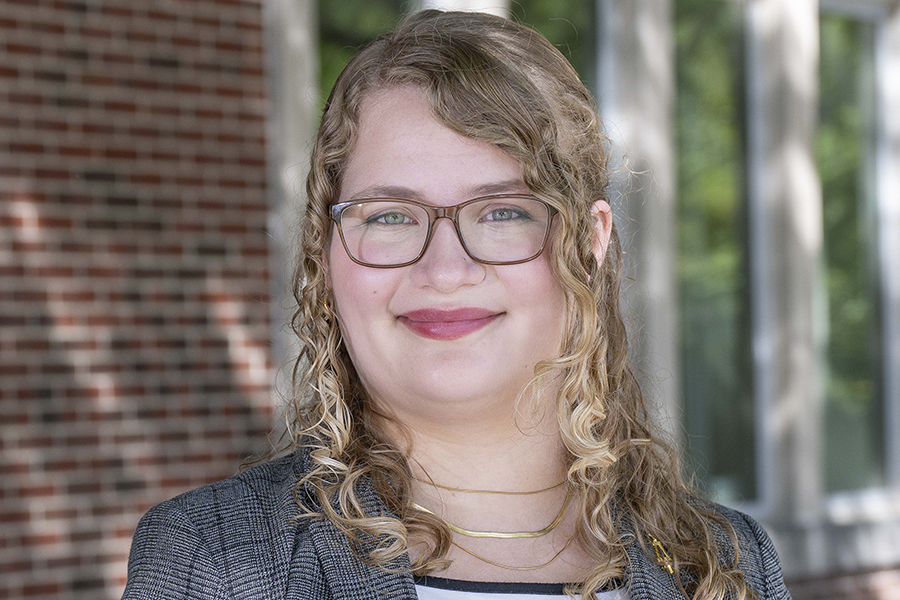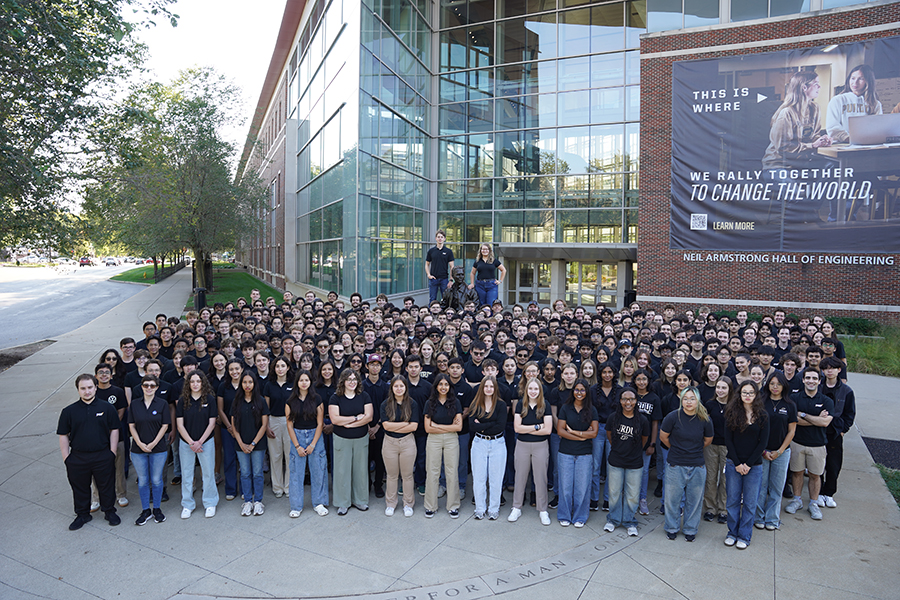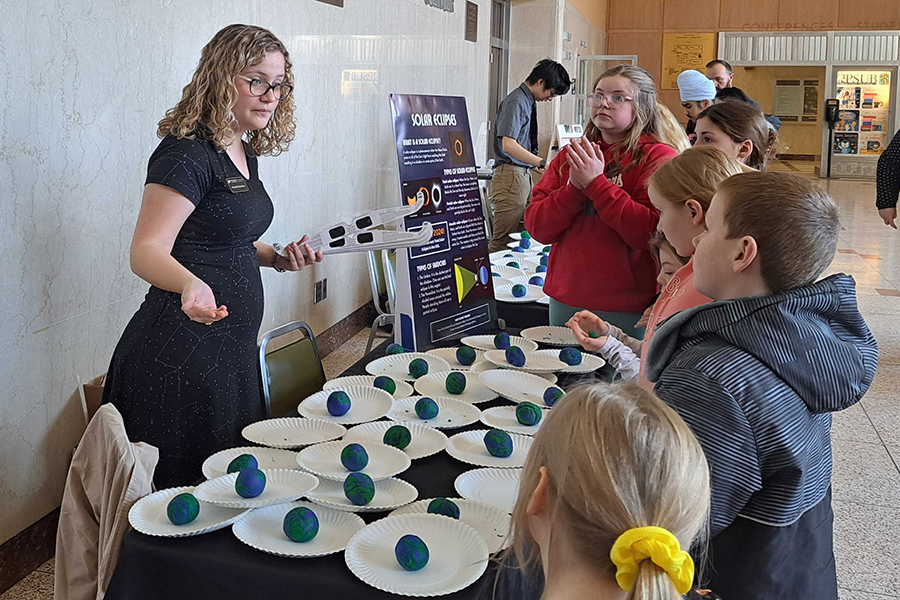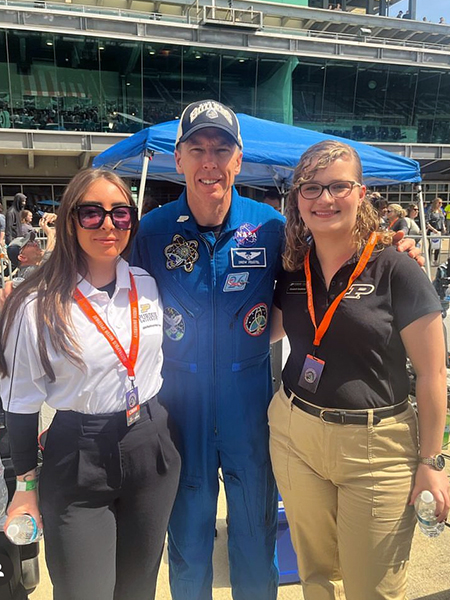PSP President, Engineering Fellow Bradshaw solidifies community through love of space

Many aeronautical and astronautical engineering (AAE) students dream of taking to the skies and soaring through the stratosphere.
Purdue Engineering Fellow and AAE senior Elizabeth Bradshaw would much rather stay on the ground, a headset on and communicate with the engineers who are space bound.
That, and she promised her mom while on a family trip to the Smithsonian National Air and Space Museum that she would keep both feet on the ground.
“The idea of being in the Mission Control room, working on something that really matters, high stakes but engaging … working with the best people, the best team and helping the mission move forward is something that really speaks to me,” said Bradshaw from Fairfax, Virginia.
It’s a passion for all things space — and, as a career path, helping others engage with theirs — that brought Bradshaw to the attention of Barrett S. Caldwell, a professor who holds a joint appointment in AAE and with the Edwardson School of Industrial Engineering.
Caldwell was impressed with Bradshaw. So impressed that he nominated her for the seventh cohort of Engineering Fellows.
“(Her) leadership roles and ongoing efforts demonstrate how committed and tireless Ms. Bradshaw is in pursuing co-curricular efforts in supporting her engineering education as an Aeronautics and Astronautics student,” Caldwell wrote in his support of Bradshaw’s nomination.
To be recognized as a Fellow was a surprise and honor for Bradshaw, who is a combined BSAAE/MSAA Program student. Purdue Engineering Fellows are considered some of the best students Purdue University has to offer, whose achievements make a positive mark on the university and beyond. They receive $25,000 upon graduation from benefactors Robert H. Buckman (BSChE ’59) and Joyce A. Mollerup.
Even before Bradshaw was merchandise chair in 2023, technical director in 2024 and president in 2025, she knew the Purdue Space Program (PSP) would be her home for growth and impact.
A community for rocketeers
Bradshaw was homeschooled until she graduated high school in 2022. Coming from a small community where she could try everything, the 45,000 strong student body of Purdue — and the endless organizations available to her — proved overwhelming. The only org that held her interest past sophomore year was PSP.

Bradshaw encountered PSP during a college fair after an on-campus tour in spring 2022. She spent almost an hour talking to the president about the wonders of space and the cool factor of working with rockets.
She was delighted to find out that there were almost 500 Purdue Engineering students who shared her interests. Making friends was a breeze within PSP — all she had to do was share her own love of space and space tech.
“What I love about PSP and Purdue is everyone's their own flavor of nerd,” Bradshaw said with a smile. “It’s a good community, everyone's passionate about what they do. They're involved because they want to make a difference.”
Bradshaw has held roles in all capacities as a member of PSP but has gravitated toward leadership. Instead of building the rockets or designing parts — both of which she has done with great enthusiasm before — she organized tech company visits to Purdue, including both familiar companies and new ventures.
Her efforts are starting to pay off: Companies have begun reaching out to PSP for recruiting events or speaking engagements before Bradshaw can even reach out to them. The self-sustaining relationship benefits both parties: Companies find future employees and students gain real-world connection and professional project feedback.
“We've had a couple of really motivated fundraising chairs who initially reached out to companies for money, but then it turns into these partnerships and these recruiting relationships,” Bradshaw said. “They start coming for recruitment and know we have good people, and I know that (the company is) a good place to work.”
Under Bradshaw’s leadership, PSP expanded from seven teams to 10 and grew from less than 500 members to nearly 600. And while she might not be working with rockets at the moment, as the primary distributor of the student org’s budget funds, she’s still very involved in the 10 teams’ goals.
“The most important part of that being able to sort of see their perspective on why they really care about this project, but then also be able to look at the big picture,” she said. “I've got nine other teams and trying to figure out where to best send those resources is definitely a challenge, but a fun one.”
Budgeting considers not only research funding but also networking and social events between PSP teams, prospective team members and future employers. But Bradshaw’s structure of a “career fair” is inverted with the PSP showcases: Where most fairs have students approaching employers with a resume, it’s recruiters who are wandering from table to table to pitch their companies to students. PSP members get to act as experts and show off their work to professionals — which some students prefer to the typical interview format.
And there are dozens more of these opportunities for students to meet employers while deeply in their element.
Bradshaw credits a vast network of support and excited, motivated friends with PSP’s successes.
“Nothing about going to college and being an adult for the first time is easy,” she said. “So having people who are going through that transition at the same time really matters. I've had great friends over the last couple of years, and it's made a big difference.”
Reaching the stars from a laptop
At 20 years old, Bradshaw has not only left a mark at Purdue, but among the stars. Literally.
“Between the different constellations of satellites I've worked on at Iridium and later at SpaceX, I have code running about 70% of the world's active satellites,” Bradshaw said of internship opportunities. “It’s one of my favorite fun facts.”

Bradshaw’s internship with Iridium in the summer of 2023 kicked off with a satellite launch where she, just days from officially starting her internship, sat amid an active mission control. It was the perfect opportunity to see what it really took to thrive in a high-stakes space that most would consider behind the curtain.
The internship had Bradshaw professionally using the engineering curriculum, entrenched in coding, power optimization, data analysis and troubleshooting communication issues between satellites and ground control. As a bonus, Iridium was in Leesburg, Virginia, only 40 minutes from her hometown. Bradshaw could spend time with her family each weekend and talk about the exciting things she was working on with her parents, who have engineering backgrounds.
“I think a lot of people, myself included, find success starting in these sort of smaller places,” Bradshaw said of Iridium, which has fewer than 1,000 employees. “It’s a lot easier to fit in in that environment and actually make some sort of contribution.”
The following summer, Bradshaw made a cross-country trek to SpaceX in Hawthorne, California, to work as a Starshield GNC engineering and operations intern. Her projects as the sole intern included spearheading data analysis from satellite constellations, working with troubleshooting communication between in-flight satellites and ground control, and improving satellite software.
The internships balanced out Bradshaw’s previous experiences with teaching, communicating and interviewing done for her published book.
While still in high school — and in between astronomy classes — Bradshaw interviewed 18 women in space-related careers to get an idea of what she could do with a love for the stars and all things rockets. She published what she learned from the interviews in “Your Place in Space: a Career Guide for Girls.”
In 2022, Bradshaw reached out to Caldwell — who, in addition to a joint professorship, is also the director of the Indiana Space Grant Consortium — about using “Your Place in Space” in Purdue K-12 educational outreach campaigns. She had already used it as part of her project work in the Engineering Honors Program, “Leading Women towards Space Careers,” and saw the potential to do more to inspire Purdue.
Caldwell was sold, based on Bradshaw’s experience and drive to teach and empower. He proposed expanding her project’s use to nearby schools as hype for the total solar eclipse in 2024. Each event had Bradshaw in the classroom, asking children about their interests andsharing about future careers.

The largest event she did to get students excited about the total solar eclipse was with the central Indiana BSA — now called Scouting America — troops. Hosted at Purdue with 40 student volunteers, Bradshaw led scouts through hands-on space and science career-related activities she developed with a team. Puzzles included decoding and encoding images about space communications and making dry ice comets with household ingredients to learn about the solar system.
“(The opportunity) sounded really interesting to me because I had done outreach before,” Bradshaw said. “It was a nice opportunity. The eclipse was super cool, and people were super excited about astronomy, and it was a nice way to sort of segue into other activities. (Caldwell) gave me a lot of leeway and a lot of flexibility to plan things on my own. I really got to take the lead and take initiative on those (events).”
To make matters better, she was on-site at the Indianapolis Motor Speedway (IMS) in April 2024 where 50,000 attendees gathered to watch the eclipse as part of an event collaboration with IMS, Purdue University and NASA. As a visiting author and volunteer for the Leading Women towards Space Careers program (now the Amelia Earhart Leadership in Space Careers program), Bradshaw signed almost 600 copies of her book for excited attendees.
And shared about PSP whenever possible.
The model of Bradshaw’s work was perfect for creating eclipse event hype. If someone was interested in the science of the sun, she would introduce the concept of a heliophysicist. If someone was interested in telescopes, she would connect them to information on being a telescope designer.
Connecting young students with fascinating careers in engineering is something Bradshaw plans to continue as she transitions from student to full-time professional after she finishes the master’s program. Being selected as an Engineering Fellow was a confidence refresher and sets up an exciting future.
Wherever she lives in the pockets of air and space engineering throughout the U.S., Bradshaw plans to use the Engineering Fellows’ cash award to pay for an apartment or furnishing a house to host friends, new and old, and enjoy baking.
“The Engineering Fellowship is a big, ‘I did it!’ Bradshaw said. “There are so many times when you're just plugging away at homework and trying to stay on top of the next deadline. But when I received that email … it was reassuring to know that somewhere, someone saw what I was doing, and it mattered.”